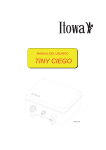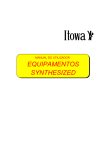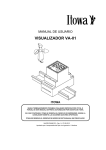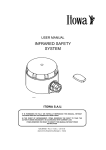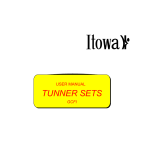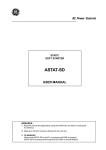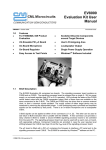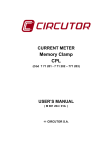Download TINY-BLIND
Transcript
OPERATOR’S MANUAL TINY-BLIND TINY-BLIND USER’S MANUAL ITOWA S.A.U. ANY REPRODUCTION, EITHER COMPLETE OR IN PART, OF THIS MANUAL IS STRICTLY PROHIBITED UNLESS ITOWA HAS GIVEN ITS WRITTEN CONSENT OTHERWISE, ITOWA RESERVES THE RIGHT TO INITIATE ALL APPROPRIATE ACTIONS AS ESTABLISHED IN LAW ITOWA RESERVES THE RIGHT TO MODIFY THIS MANUAL WITHOUT PRIOR ADVICE MATCGB. DOC 27-09 - 00 SLS TINY BLIND USER´S MANUAL INDEX 1. INTRODUCTION 1-1 2. DESCRIPTION OF THE RADIO-CONTROLLED EQUIPMENT 2-1 2.1. TRANSMITTER 3. TECHNICAL DATA 2-1 3-1 3.1. OVERALL DATA OF THE SYSTEM 3-1 3.2. TRANSMITTER 3-1 4. START-UP AND OPERATION 4-1 5. TRANSMITTER MAINTENANCE 5-1 6. TROUBLESHOOTING 6-1 ANNEX A. ADDRESS A-1 TINY BLIND USER´S MANUAL 1. INTRODUCTION The present manual is a guide for the proper operation of the multi-frequency remote control family from ITOWA. This equipment has been especially designed for the wireless remote control of any machines incorporating electromechanical drives. Radio-transmitted control signals are transmitted using frequency modulation (FM) and FFSK keying. The most advanced technology and latest-generation microprocessors have been used in the electronic design, providing total safety for radio-control yet operation. To prevent incorrect operations from being executed, the system is equipped with several safety devices that are described in next chapters. When any abnormalities are self-detected, the system locks any controls operation that is commanded. The system operates in the UHF frequency band, as required by the I-ETS 300 220 telecommunications standard, having obtained the type approvals and national standards in the following countries: SPAIN UK EIRE FRANCE GERMANY FINLAND ICELAND BELGIUM HOLLAND PORTUGAL SWEDEN E 08 98 0076 13397 13988 TRA 24/5/124 Nº 98 0169 PPL 0 D800517K FI98080090 IS-3025-00 IS-3024-00 RTT/TI/X84 CEPT LPD NL ICP-011TC-99 Ue970144 For other approvals, please check with ITOWA. 1-1 TINY BLIND USER´S MANUAL 2. DESCRIPTION OF THE RADIO-CONTROLLED EQUIPMENT Remote control units of the TINY-BLIND family consist of the following items: 1. TINY-BLIND TRANSMITTER 2. RECEIVER This manual only describes transmitter. 2.1. TRANSMITTER This is a waterproof pushbutton box (with an IP 56 degree of protection) made of high-strength plastic. This box has an input power supply (220Vac or 48 Vac). Commands from the joysticks are fed into the microprocessor-based system, which takes care of generating the FFSK signal, adding the directional and control codes to it, and injecting the signal to the HF transmitter. The transmitter incorporates this command signal to its carrier frequency, which after being filtered, will be sent by the antenna. As shown in the block diagram (Fig. 2.1), the transmitter pushbutton box can be divided into three sections: pushbutton section, control circuit section and HF transmitter section. PUSHBUTTONS SWITCHES CONTROL ELEMENTS MODULATOR TRANSMITTER Fig. 2.1 Pushbutton box block diagram (Fig. 2.2) reproduces a detailed overview of the operating and control elements: 2-1 TINY BLIND USER´S MANUAL 1 4 5 8 7 1/2 2 3 2 3 1 0 4 0 0 1 START STOP 6 RELEASE AUXILIARY ALARM START EMERGENCY STOP TRANSMITTER 1 VA000565 Fig. 2.2 Description of the transmitter 2-2 TINY BLIND USER´S MANUAL 3. TECHNICAL DATA 3.1. OVERALL DATA OF THE SYSTEM Manufacturer INVESTIGATION TOTAL WARE S.A.U. Model TINY-BLIND Type Multi-frequency Frequency ISM-BAND Number of commands To 32 orders Possibility of incorrect operation 1·10 Hamming distance =6 Programmable codes 16777216 Command response time <50 ms Active emergency time <50 ms Passive emergency time 1900 ms Operating range < 90 meters * -18 3.2. TRANSMITTER Frequency band: UHF 433.050 to 434.750 MHz Channel spacing: 25 kHz Modulation: FM Transmitting power: 10 mW A.R.P. Keying: FFSK Frequency stability: ± 2.5 ppm (from -30ºC to 70ºC) Harmonics damping: > 70 dB Transmitting power consumption: 110 mA Standby power consumption: 10 mA. Power supply: 220 Vac or 48 Vac Temperature range: from -10ºC to +55 C Material: Polyamide o Approximate weight: Dimensions: * 300 x 220 x 120 mm Frequency change must be performed by authorized personnel (see A ADDRESS) 3-1 TINY BLIND USER´S MANUAL 4. START-UP AND OPERATION Once the receiver has been installed, activating the machine’s main switch will cause the receiver LCD to go on. At this moment, the receiver is ready for operation and to receive any commands from the * transmitter. ITOWA S.A RRC32 CHANNEL: xx Put power supply into the transmitter, switch off the mushroom-head emergency pushbutton. Activating only the START ON pushbutton will cause the remote control unit to start operation by activating the stop and start relays and the main contactor will be locked. At the same time the TX ON LED will turn on indicating that the remote control unit is operating properly. From this moment on, pressing any pushbutton or joystick will activate the appropriate control operation. The control operation selected will remain active as long as the pushbutton is held in its pressed position. 0000000000000000 1100001000000011 To keep the radio channel free and prevent the operator from leaving the machine on, the remote control unit is provided with an automatic shutdown system that stops the crane. This system operates after 90 seconds have elapsed without any control operation being executed. ITOWA S.A RRC32 CHANNEL: xx To re-enable the transmitter, press again the START ON pushbutton. To activate an emergency stop, simply press the mushroom-head emergency pushbutton, which will energize the stop relays and switch the radio-controlled unit off; under this condition, all relays that are energized will be deenergized, and the initial message appears again in the LCD. ITOWA S.A RRC32 CHANNEL: xx * Indicates any channel (01-69) 4-1 TINY BLIND USER´S MANUAL CAUTION: REMEMBER THAT PRESSING THE EMERGENCY STOP MUSHROOM-HEAD PUSHBUTTON IS EQUIVALENT TO THE REMOTE CONTROL, THAT IS, ANY ACTIVATED RELAY IN THE RECEIVER WILL BE IMMEDIATELY SWITCHED OFF. 4-2 TINY BLIND USER´S MANUAL 5. TRANSMITTER MAINTENANCE Before attempting any maintenance operation, switch off the machine’s main switch. This remote control unit requires minimum maintenance. Every 3 months, please check for good condition of the transmitter, the pushbuttons, paying special attention to the gaskets and the pushbutton and joystick grommets, etc. Clean the transmitter removing any foreign matter that may have stuck to it. If any pushbutton grommets were damaged, please replace them immediately. Otherwise, water may cause the transmitter to break down. 5-1 TINY BLIND USER´S MANUAL 6. TROUBLESHOOTING This section describes the most common trouble situations of these remote control units as well as the troubleshooting procedure. If these troubles occur, carry out the following checks. 1) Checking the trouble place: Check whether the trouble is caused by the remote control unit or by the machine’s electrical circuit. To check this, simply connect the original pushbutton box to the machine or to the cabin, and make sure the crane operates properly. If the machine works properly, this means the remote control unit is broken down. Otherwise, call the machine’s technical support provider, since the trouble is caused by the crane itself. 3) Checking the transmitter: Switch on the remote control unit by releasing the mushroom-head emergency pushbutton and press the start pushbutton. The LED marked " TX OK " should turn on. If this LED goes on, it means the trouble is in the receiver. Otherwise, check the power supply. If the power supply operates properly, make sure the key and pushbutton operate satisfactorily. If these operate properly, then the trouble is in the IT3020 control and transmission module; if this is the case, have the transmitter repaired by an ITOWA authorized Technical Support Provider. (See Annex A, Page A-1) 4) Checking the receiver: Let us assume the transmitter is operating properly. Make sure the receiver is operating properly by performing the following checks: Check operation of the power supply. The LCD should be on. Otherwise, check operation of the power supply circuit and the transformer. If the power supply operates properly, press the START button on the transmitter and check whether the stop and start relays are energized. If so, check the control operation fuse. If the stop and start relays are energized, check the control circuit for those relays. If the circuit is operating properly, this means the problem lies in the IT 3021 control and HF module. If this is the case, have it repaired by an ITOWA authorized Technical Support Provider. (See Annex A, Page A-1) Check that the antenna is in good condition and make sure it is properly connected to the receiver. CAUTION: ALWAYS USE ORIGINAL SPARE PARTS FOR ANY REPAIR AND NEVER ALTER THE SAFETY FEATURES NOR THOSE OF THE HF TRANSMITTER / RECEIVER. 6-1 TINY BLIND USER´S MANUAL ANNEX TINY BLIND USER´S MANUAL A. ADDRESS ITOWA S.A.U. C/ Faraday, 159 08224 TERRASSA (BARCELONA) Tel +34-93.733.98.50 Fax +34-93.789.13.51 e-mail: [email protected] http://www.itowa.com A-1 DCTCGB – Rev. .0 EC – DECLARATION OF CONFORMITY The manufacturer: ITOWA S.A C/ Faraday, 159 E-08224 Terrassa Barcelona, España Tel.: +34 93 733 98 50 Fax: +34 93 789 13 51 According with the requirements of the R&TTE 1999/05/EC Annex III declares under its responsibility that the radio remote control equipment designated as: TINY - BLIND Are in conformity with the following European Directives: • • 98/37/EC (June, 22nd 1998) : Safety of machinery. o With the standard EN 954-1 (1996) type CLASS III concerning the main requirements of health and safety to the design and the construction of machines. o With the standard EN 60204-32 (1998) concerning the safety of machinery; electrical equipment of machines; Part 32 : Requirements for hoisting machines. o With the standard EN 13557 (2003) concerning cranes; controls and control stations. 99/05/EC (March, 9th 1999) : Radio and Telecommunications Terminal Equipment (R&TTE). o With the standard EN 60215 (1989) concerning the safety requirements for radio transmitting equipment. o With the standard EN 60215/A2 (1994) concerning the safety requirements for radio transmitting equipment. o With the standard EN 301 489-3 v1.4.1 concerning the electromagnetic compatibility and Radio spectrum Matters (ERM); Electromagnetic Compatibility (EMC) standard for radio equipment and services; PART 3 Specific conditions for Short-Range Devices (SRD) operating on frequencies between 9 kHz and 40 GHz. o With the standard EN 300 220-3 v1.1.1 concerning the electromagnetic compatibility and radio spectrum matters (ERM); Short Range Devices (SRD); Radio equipment to be used in the 25 MHz to 1.000 MHz frequency range with power levels ranging up to 500 mW; Part 3 : Harmonized EN covering essential requirements under article 3.2 of the R&TTE Directive. Signatory : Name : Ramón Faure Function : Technical Manager Place and date : Terrassa, July 15th 2011 Signature
























